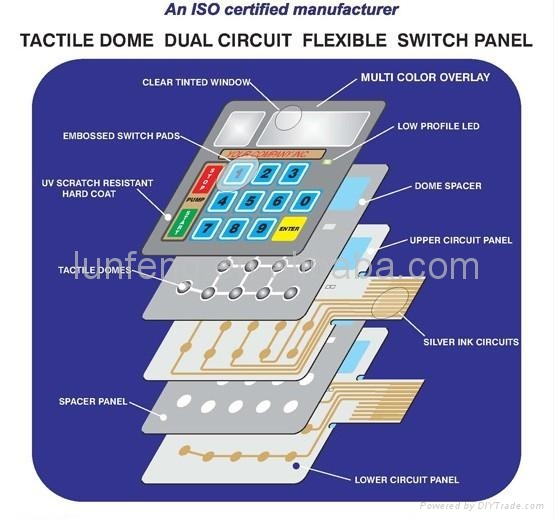Understanding Membrane Changes: The Key to Resilient and Trustworthy Controls

What Are Membrane Layer Switches?
Membrane layer buttons are an innovative service in the world of individual interface innovation, incorporating capability and style seamlessly. These devices work as an interface in between users and digital systems, incorporating a number of parts right into a compact layout. Generally constructed from flexible, slim layers of products, membrane layer buttons are designed to react to touch, making it possible for users to communicate with equipment and electronic gadgets effectively.
The main elements of a membrane layer button include a published circuit layer, graphic overlay, and a spacer layer that prevents unplanned activation. The graphic overlay can be personalized to reflect brand name identification or customer preferences, boosting aesthetic appeals while making certain use. Membrane buttons are frequently used in various applications, including medical gadgets, consumer electronic devices, and industrial devices, owing to their sturdiness and resistance to ecological variables such as wetness and dirt.
One of the vital benefits of membrane layer switches is their capacity to hold up against damage, making them excellent for high-traffic settings. Additionally, they are light-weight and need very little area, enabling for cutting-edge styles in product growth. On the whole, membrane switches over represent a functional and efficient choice for modern-day digital interfaces, marrying technology with user-centric design principles.
Exactly How Membrane Layer Switches Job
The operation of membrane layer changes rest on a simple yet effective system that equates user input into electronic signals. These switches are composed of multiple layers, generally consisting of a visuals overlay, a spacer layer, and a circuit layer. When an individual presses the switch, the top layer warps, permitting a conductive aspect in the circuit layer to make call with an equivalent conductive pad on the bottom of the graphic overlay. This get in touch with shuts the circuit and sends a digital signal to the tool, suggesting that the switch has been triggered.
The layout of membrane layer switches can differ, but they typically include domes or responsive components to provide responses to the individual, improving the general experience - membrane switch. The materials made use of in membrane buttons, such as polyester or polycarbonate, add to their durability and resistance to environmental elements, consisting of wetness and dirt. The printed circuits are generally encapsulated, which protects them from wear and tear over time.
Benefits of Membrane Buttons

In addition, membrane layer switches are understood for their durability. Constructed from robust materials, they are immune to dust, moisture, and physical wear, which substantially expands their lifespan contrasted to traditional mechanical switches. This longevity makes them particularly suitable for high-traffic settings and applications requiring durability.
An additional considerable advantage is the ease of cleansing and maintenance. The smooth surface area of membrane changes decreases dirt accumulation and is usually unsusceptible spills, making them perfect for settings that call for frequent sanitization.
Moreover, membrane layer buttons offer a streamlined profile, bring about a thinner layout that can be incorporated right into different gadgets without including bulk. This feature not only boosts the aesthetic appeal however also adds to a more ergonomic item style.
Applications of Membrane Layer Switches
Straightforward and functional, membrane buttons find applications throughout a vast array of industries, including clinical gadgets, consumer electronic devices, and industrial devices. In the clinical area, these buttons are indispensable to gadgets such as analysis tools, patient find surveillance systems, and infusion pumps, where reliability and convenience of cleansing are critical. Their capability to maintain and stand up to rough environments capability makes them perfect for such applications.

In customer electronics, membrane layer buttons are used in items like microwaves, cleaning machines, and remote controls - membrane switch. Their smooth style permits intuitive interface, improving the overall customer experience while providing toughness and resistance to tear and wear
Industrial devices likewise profits from membrane layer switches, particularly in control panels for equipment and automation systems. These switches supply defense versus dirt and moisture, guaranteeing consistent performance in challenging environments. Their customizable functions permit suppliers to customize them to certain functional demands, boosting efficiency and performance.
Choosing the Right Membrane Switch
When choosing a membrane button, it is important to think about numerous variables that affect efficiency and suitability for particular applications. The key factors to consider consist of ecological conditions, responsive responses, sturdiness, and layout specs.
First, assess the operating atmosphere; buttons subjected to wetness, chemicals, or extreme temperature levels call for specific products to ensure durability and functionality. Next, review the requirement for tactile comments. Depending on customer interaction, some applications may gain from a responsive reaction to verify activation, while others may choose a non-tactile style for visual factors.
Toughness is an additional important element; membrane switches ought to be designed to endure frequent use, effects, and abrasion. Ensure go to my site the chosen button can sustain click for info the anticipated lifecycle, especially in high-usage situations.

Verdict
In conclusion, membrane switches offer as crucial elements in the design of trustworthy and durable control systems across different sectors. The flexibility of membrane layer changes permits for tailored options that fulfill specific functional needs, strengthening their relevance in modern innovation.
Membrane switches represent a critical facet of modern interface layout, blending performance with durability in numerous applications.Membrane buttons are an advanced option in the realm of user interface technology, combining performance and design flawlessly. Normally built from versatile, thin layers of materials, membrane switches are created to respond to touch, allowing customers to engage with equipment and electronic gadgets properly.
The style of membrane switches can differ, but they commonly include domes or tactile elements to provide comments to the individual, improving the general experience.In final thought, membrane layer switches offer as important elements in the design of long lasting and reputable control systems throughout numerous sectors.